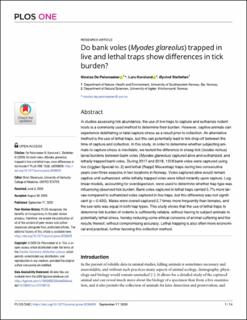| dc.contributor.author | De Pelsmaeker, Nicolas | |
| dc.contributor.author | Korslund, Lars | |
| dc.contributor.author | Steifetten, Øyvind | |
| dc.date.accessioned | 2020-11-18T10:55:49Z | |
| dc.date.available | 2020-11-18T10:55:49Z | |
| dc.date.created | 2020-10-30T16:43:05Z | |
| dc.date.issued | 2020 | |
| dc.identifier.citation | De Pelsmaeker, N., Korslund, L., & Steifetten, Ø. (2020). Do bank voles (Myodes glareolus) trapped in live and lethal traps show differences in tick burden?. Plos one, 15(9), e0239029. | en_US |
| dc.identifier.issn | 1932-6203 | |
| dc.identifier.uri | https://hdl.handle.net/11250/2688438 | |
| dc.description.abstract | In studies assessing tick abundance, the use of live traps to capture and euthanize rodent hosts is a commonly used method to determine their burden. However, captive animals can experience debilitating or fatal capture stress as a result prior to collection. An alternative method is the use of lethal traps, but this can potentially lead to tick drop-off between the time of capture and collection. In this study, in order to determine whether subjecting animals to capture stress is inevitable, we tested the difference in sheep tick (Ixodes ricinus) larval burdens between bank voles (Myodes glareolus) captured alive and euthanized, and lethally trapped bank voles. During 2017 and 2018, 1318 bank voles were captured using live (Ugglan Special no. 2) and lethal (Rapp2 Mousetrap) traps during two consecutive years over three seasons in two locations in Norway. Voles captured alive would remain captive until euthanized, while lethally trapped voles were killed instantly upon capture. Loglinear models, accounting for overdispersion, were used to determine whether trap type was influencing observed tick burden. Bank voles captured in lethal traps carried 5.7% more larvae compared to euthanized voles captured in live traps, but this difference was not significant (p = 0.420). Males were overall captured 2.7 times more frequently than females, and the sex ratio was equal in both trap types. This study shows that the use of lethal traps to determine tick burden of rodents is sufficiently reliable, without having to subject animals to potentially lethal stress, hereby reducing some ethical concerns of animal suffering and the results thereof, without compromising accuracy. Lethal trapping is also often more economical and practical, further favoring this collection method. | en_US |
| dc.language.iso | eng | en_US |
| dc.rights | Navngivelse 4.0 Internasjonal | * |
| dc.rights.uri | http://creativecommons.org/licenses/by/4.0/deed.no | * |
| dc.title | Do bank voles (Myodes glareolus) trapped in live and lethal traps show differences in tick burden? | en_US |
| dc.type | Peer reviewed | en_US |
| dc.type | Journal article | en_US |
| dc.description.version | publishedVersion | en_US |
| dc.rights.holder | © 2020 De Pelsmaeker et al. | en_US |
| dc.source.pagenumber | 1-14 | en_US |
| dc.source.volume | 15 | en_US |
| dc.source.journal | PLOS ONE | en_US |
| dc.source.issue | 9 | en_US |
| dc.identifier.doi | https://doi.org/10.1371/journal.pone.0239029 | |
| dc.identifier.cristin | 1843719 | |
| dc.source.articlenumber | e0239029 | en_US |
| cristin.ispublished | true | |
| cristin.fulltext | original | |
| cristin.qualitycode | 1 | |

